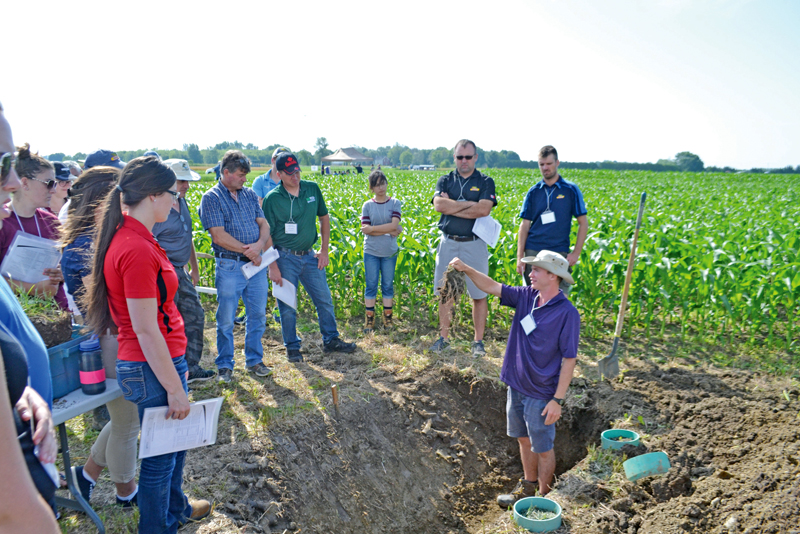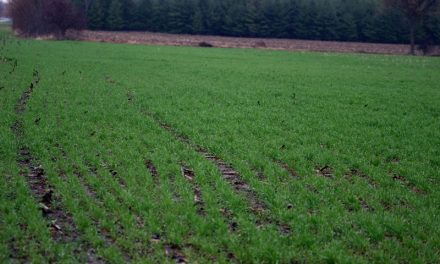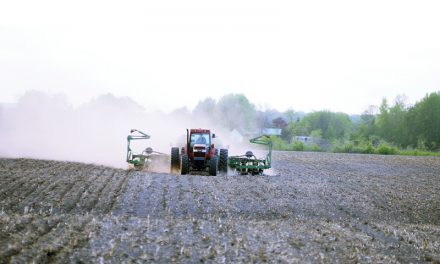Deep roots
Sebastian Belliard showed groups the difference between healthy soil structures and unhealthy structures at the Eastern Ontario Crop Diagnostics Day in Winchester on Wed., July 19. Sawyer Helmer photo
by Kalynn Sawyer Helmer
AgriNews Staff Writer
WINCHESTER – The Eastern Ontario Crop Diagnostics Day took place in Winchester at the Winchester Research Centre. The long-standing event is a collaborative effort between the Ontario Ministry of Agriculture, Food and Rural Affairs (OMAFRA) and the Eastern Ontario Crop Advisory Committee. Just like previous years, 11 stations were set up around the research centre’s fields with industry professionals on site to give 25-minute demonstrations. Attendees were filed into smaller groups to visit each station. During lunch and after the event finished, the speakers were available for further questions.
The first station was titled Weed I.D. with Holly Byker, a cropping systems research technician.

Horst Bohner spoke to participants about soybeans and gave a tour through the field examining different effects of pesticides, nutrients and rolling practices. Sawyer Helmer photo
Up next was Farming in 3D with Sebastian Belliard, OMAFRA’s Soil Management Specialist for field crops in Eastern Ontario, and Chris Brown, Nutrient Management Field Crops Program Lead. Four soils were on display at the station where participants were asked to identify which soil was best and which was worst. The point of the exercise focused on identifying good soil structure, one that breaks apart like crumbs. Brown explained, “Soil structure has a very big impact on how water moves through the soil and how crops access water.” The key part identified was the pores between aggregates which allow for aeration and water infiltration. “Pores are a key part of soil structure. You need pores for roots to be able to penetrate,” said Belliard. The station showed the differences between good soil structures and poor structures. Brown helped to identify little layers of plates that can happen naturally with water but indicate consolidation. However she went on to explain that it can be in part rectified with tillage. Belliard concluded that while there are certain components that cannot be changed about the biology of a field, “structure is dynamic and can respond quickly to management.”
The third station was Cereal Opportunities and Challenges with Joanna Follings, Cereals Specialist with the Field Crop Unit of OMAFRA. The station identified malting barley varieties and cereal management practices.
This was followed by Nitrogen Management in Corn with Jake W. Munro, Soil Fertility Specialist for the Field Crops Unit of OMAFRA, and Ben Rosser, Field Crop Corn Industry Program Lead for OMAFRA. At this station, Munro and Rosser presented evidence from field trials that sidedress injection which leads to less risk of ammonia loss and potential higher yields compared to dribble or drop nozzles.
At station five, Horst Bohner led the discussion of Soybeans. Bohner has been the provincial soybean specialist with OMAFRA since 2001. He began by insisting that nutrient deficiency in soybeans can occur even in wet structures like the soil has experienced this year and the days of leaving soybeans alone are over. “If we are going to get to 60, 80, 100 bushels consistently then we have to learn how to manage them,” said Bohner. The station went on to examine different effects farming practices have on soybeans. Bohner explained in low soil tests the plant’s response to phosphorus was equal to that of potash when applied together. An outcome Bohner said he was surprised to see since potash is taught as the usual one product fix. This was not the case, however, in high soil tests.
Before moving on to the next station, Bohner explained the potential benefits for rolling. The best time being “early enough but not too early. On Bohner’s own field he says he waits until the first trifoliate (V1) before rolling and does so during a hot dry afternoon since the plants are more limp than in the morning. When one participant asked how long he should wait before going back to the field, to avoid a defeated feeling from rolling crops, Bohner insisted that when done properly the plant should make its way back upright by the same night or next morning. However with all things farming related, it is dependent on what works for each particular field and farmer.
The sixth stop was Diseases I.D. and Management with Albert Tenuta, a Pathologist – Field Crops for OMAFRA. Onsite of most interest to Tenuta was the wheat, one side fungicide and the other not. Tenuta encouraged listeners to monitor their wheat fields for bleached white or pinkish heads from Fusarium Head Blight. For corn Tenuta outlined four main issues, Northern Corn Leaf Blight identifiable by long oval lesions, Common Corn Rust identifiable by rusty coloured pustules, Gray Leaf Spot identifiable by rectangular lesions and Eyespot identifiable by small round lesions. Northern Corn Leaf Blight, Tenuta insisted was a large problem for Eastern Ontario and can cause a hit of 20 to 40 bushels.
Next was the Dicamba Stewardship station with Mike Cowbrough, Weed Management Lead for OMAFRA, and Jason Deveau, Application Technology Specialist with OMAFRA. This station compared the effectiveness of triple rinsing and continuous rinsing, with and without ammonia-based cleaner.
The eighth station, Western Bean Cutworm with Tracey Baute, Field Crop Lead Entomologist, helped participants to identify the insect and covered some of the new trapping technology and management strategies.
This was followed by Strip Tillage and More Tillage with Peter Johnson, Agronomist. The station examined vertical. high-speed disc, plowing and crop residues.
The second last stop on the tour was Soil is Alive! with Adam Hayes, Soil Management – OMAFRA, where participants got a close up look at what lives in the soils and effects management has on those living organisms.
Lastly, the Diagnostic Stop with Ian McDonald, Crop Innovations-OMAFRA, challenged participants’ diagnostic skills relating to field crops and modern issues,
The day was informative for the participants and a good opportunity to ask questions tailored to personal fields. With access to so many professionals and experts, the benefits of the event were evident to the 290 people who attended the full-day event.













